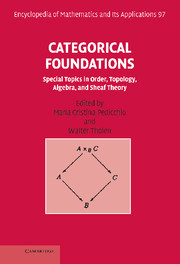Book contents
- Frontmatter
- Summary of Contents
- Preface
- Contents
- Introduction
- I Ordered Sets via Adjunction
- II Locales
- III A Functional Approach to General Topology
- IV Regular, Protomodular, and Abelian Categories
- V Aspects of Monads
- VI Algebraic Categories
- VII Sheaf Theory
- VIII Beyond Barr Exactness: Effective Descent Morphisms
- Index
I - Ordered Sets via Adjunction
Published online by Cambridge University Press: 05 November 2013
- Frontmatter
- Summary of Contents
- Preface
- Contents
- Introduction
- I Ordered Sets via Adjunction
- II Locales
- III A Functional Approach to General Topology
- IV Regular, Protomodular, and Abelian Categories
- V Aspects of Monads
- VI Algebraic Categories
- VII Sheaf Theory
- VIII Beyond Barr Exactness: Effective Descent Morphisms
- Index
Summary
‘Sets for Mathematics’, by F.W. Lawvere and R. Rosebrugh, [5] is a ground-breaking, undergraduate, set theory textbook. Categories provide the metalanguage and, for a substantial part of the book, axioms are gradually imposed on a category S until its objects and arrows capture the key features of sets and functions that are used in mathematical practice. To those who would say that sets and functions are themselves lurking in the definition of category, the rejoinder should surely be that sets and functions are present to the same extent in the metalanguage of traditional set theory texts. By the time a student starts to think critically about sets and functions in an undergraduate mathematics program, he or she has already implicitly studied several categories—continuous, differentiable, linear, order-preserving, and so on. It is to these categories, and other categories of mathematical structures, that a student turns repeatedly in the course of studying Mathematics. To see these categories as categories of sets with structure, it seems to this writer most appropriate to put the formal study of sets themselves on the same footing.
Lawvere and Rosebrugh accomplish in [5] much more than is possible in a traditional set theory book because they isolate those categorical axioms for sets and functions that allow sets to admit both variation and the intuitionistically valid constructs and theorems of the subject. A category satisfying the axioms in question is called a(n elementary) topos.
- Type
- Chapter
- Information
- Categorical FoundationsSpecial Topics in Order, Topology, Algebra, and Sheaf Theory, pp. 5 - 48Publisher: Cambridge University PressPrint publication year: 2003
- 6
- Cited by

